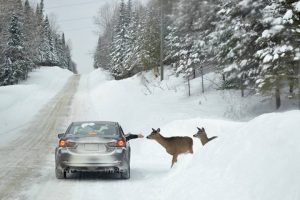Examining the Interacting Roles of Social Influences and Risk Perceptions on Behavioral Non-Compliance with Wildlife
 In New Brunswick, a certain group of the public is feeding deer during the winter season as they’re concerned that deer populations are decreasing. Reasons behind feeding may vary depending on the person but feeding could be driven by a want to maintain deer populations for hunting or concerns over the amount of winter browse available for deer. Feeding deer is not illegal but is not supported by the New Brunswick’s Provincial government. Feeding is illegal in Maine between June 1st to December 15th. Public feeding occurs on various scales, with backyard feeders feeding around 20 deer per day, to large-scale feeders who regularly feed around 400 deer per day. Satellite tracking data from collared deer in the area has confirmed that deer migration patterns have shifted accordingly, with the traditional forest stands empty of deer in the winter, and high numbers present throughout residential areas. Humans feeding deer may have implications for a number of factors regarding deer population health, and public health and safety, including: vehicle-deer collisions; a growing concern about the introduction of deer-dependent Lyme disease-carrying ticks; and social conflicts between those who feed and their neighbors concerned about these risks. The goal of our study is to better understand the personal motivations, perceptions toward deer and deer management, and the broader social influences on deer feeding in the northwest region of New Brunswick.
In New Brunswick, a certain group of the public is feeding deer during the winter season as they’re concerned that deer populations are decreasing. Reasons behind feeding may vary depending on the person but feeding could be driven by a want to maintain deer populations for hunting or concerns over the amount of winter browse available for deer. Feeding deer is not illegal but is not supported by the New Brunswick’s Provincial government. Feeding is illegal in Maine between June 1st to December 15th. Public feeding occurs on various scales, with backyard feeders feeding around 20 deer per day, to large-scale feeders who regularly feed around 400 deer per day. Satellite tracking data from collared deer in the area has confirmed that deer migration patterns have shifted accordingly, with the traditional forest stands empty of deer in the winter, and high numbers present throughout residential areas. Humans feeding deer may have implications for a number of factors regarding deer population health, and public health and safety, including: vehicle-deer collisions; a growing concern about the introduction of deer-dependent Lyme disease-carrying ticks; and social conflicts between those who feed and their neighbors concerned about these risks. The goal of our study is to better understand the personal motivations, perceptions toward deer and deer management, and the broader social influences on deer feeding in the northwest region of New Brunswick.
Collaborating Research Group: Northeast Deer Research Partnership
In Collaboration with: Quality Deer Management of New Brunswick, University of Moncton Edmundston, Province of NB Department of Energy and Resource Development
Photo Credit: Daniel Gautreau
